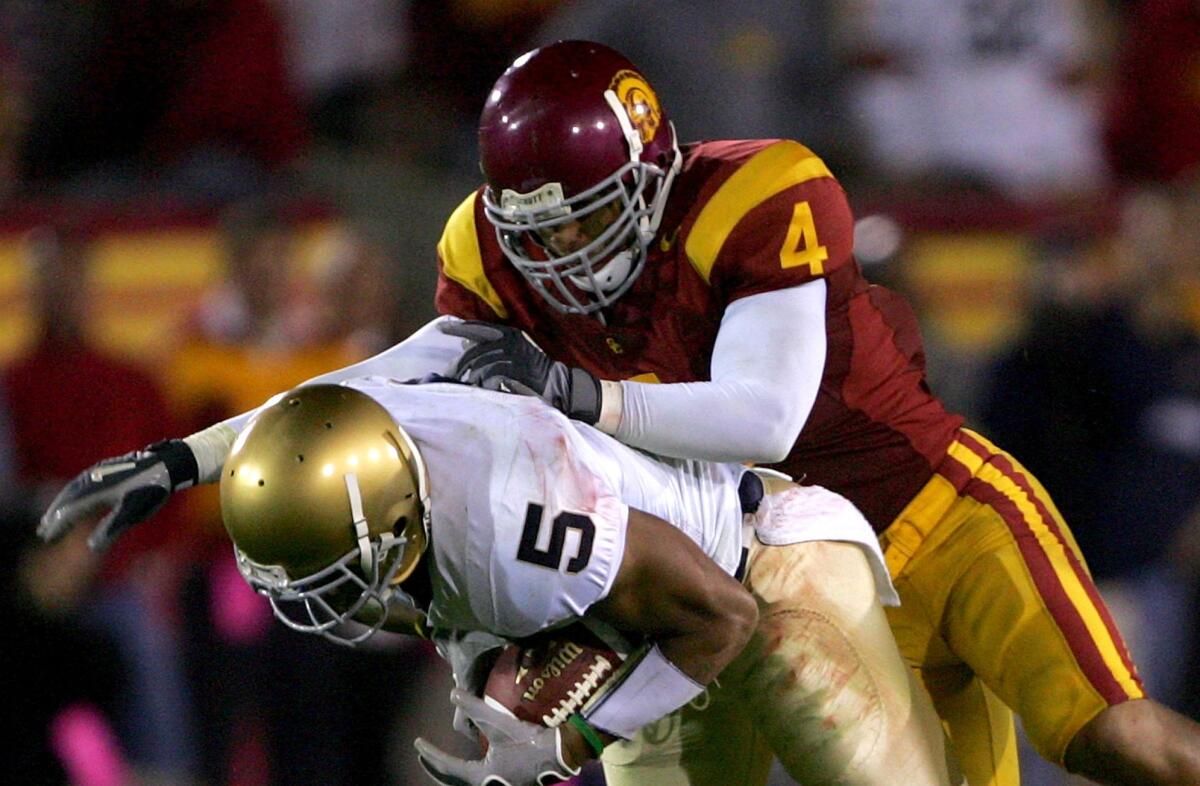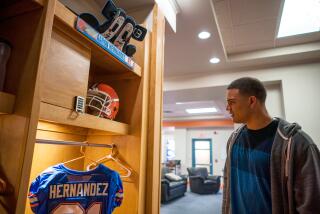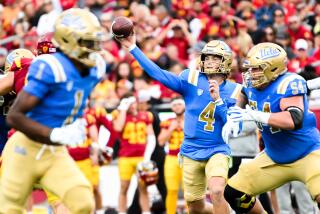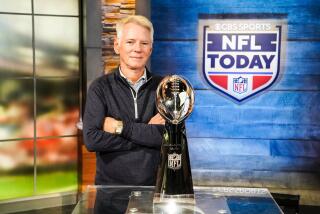Column: So long as football thrives, the Kevin Ellisons will pay the toll

The climax of the football season is almost here.
The California state high school championship games will be played in a week and a half. College bowl season will start the week after that. The NFL playoffs begin Jan. 4.
New heroes will emerge, their achievements celebrated, their signature moments recorded as the latest chapters in the sport’s mythology.
Obscured by the revelry is an uncomfortable reality of how the games will also produce Kevin Ellisons.
On the grass stage of their dreams, they will be hurling themselves toward their demise. The game they love will destroy them.
A former all-conference defensive back at USC, Ellison died in October 2018 when he was fatally struck by a minivan as he wandered on the northbound lanes of the 5 Freeway in the San Fernando Valley. He was 31.
Ellison’s descent to mental illness was chronicled in a haunting front-page article by Nathan Fenno that appeared in Tuesday’s print edition of The Times. A posthumous examination of his brain revealed that the former Trojans team captain had CTE, the neurodegenerative disease caused by repeated head trauma.
Kevin Ellison was known for hard hits while playing for USC and the Chargers. Did that lead to increasingly bizarre behavior before his death?
The call crackled over the California Highway Patrol scanner as darkness enveloped Interstate 5 in the San Fernando Valley.
The finding wasn’t shocking, in large part because of how he played. Ellison was known as a particularly hard hitter.
The same vicious tackles that made him a popular player could be what led to his death.
This paradox was unintentionally captured in a tweet by USC’s athletic department a few days after he died. “The late, great Kevin Ellison,” read the message, under which there was a video of Ellison delivering a helmet-to-helmet shot on Cal receiver DeSean Jackson.
“Oh, man,” said the broadcaster calling the game. “DeSean Jackson almost got beheaded by Kevin Ellison.”
The details of Ellison’s post-playing days mirrored the experiences of others with similar brain conditions. The likable Ellison became a different person. Living in an apartment in Inglewood, Ellison experienced constant headaches. He heard voices. He had an economics degree, but couldn’t hold down a job.
While the links between CTE and mental illness remain unclear, the dangers associated with playing football have been scientifically established for more than a decade.
More than 100 former NFL players tested post-mortem were confirmed to have CTE. Several died by suicide, including Hall of Famer Junior Seau, also a former USC star, and convicted murderer Aaron Hernandez.

The abundance of CTE cases has raised concerns — to a degree.
Youth football participation has declined over the last decade.
Some high-profile players have retired early from the NFL for health reasons, among them former Indianapolis Colts quarterback Andrew Luck.
For players who continue to play the game, new rules have been implemented to discourage high-impact collisions.
But …
Well, football is still football. The game will always be violent.
This is why the sport is appealing. We Americans are enamored with violence, so long as that violence isn’t directed at us. And with its field generals, blitzes and patriotism-cloaked games, football is war simulation.

The more conscientious fan might voice his or her disapproval of how the NFL initially refused to acknowledge links between concussions in football and long-term neurological problems.
He or she might take issue with college football’s exploitative nature.
And he or she might acknowledge that the only way to ensure there won’t be another Kevin Ellison would be to outlaw football entirely.
But to actually advocate to ban football?
Not happening, at least not in the numbers required to make a change. The game is too ingrained in our culture, so much so that eliminating the sport is an idea that we have never seriously entertained.
What is certain to be compromised, however, is the level of play. Football figures to encounter some of the same problems that resulted in the decline of another sport affected by brain injuries: boxing.
For more than a decade, researchers trying to make sense of the mysterious degenerative brain disease afflicting football players and other contact-sport athletes have focused on the threat posed by concussions.
As is the case in boxing, the talent pool is shrinking. And as is the case in boxing, an increased emphasis on athlete safety is limiting how much time football players spend working on their craft. Similar to how the modern boxer who spars only three days a week is less likely to develop the same skill set as his better-trained predecessors, football players who rarely practice tackling are less likely to develop as effective tackling technique.
But football has safeguarded itself against this inevitable decline in quality by selling more than football. As long as the game is part of the college experience, as long as there are tailgate parties and fantasy leagues, football will remain a thriving business.
Players will continue to take the field in pursuit of wealth. Some of them will realize their ambitions. Others will end up like Ellison.
More to Read
Go beyond the scoreboard
Get the latest on L.A.'s teams in the daily Sports Report newsletter.
You may occasionally receive promotional content from the Los Angeles Times.












